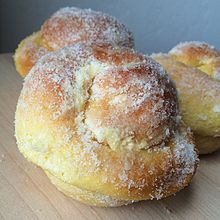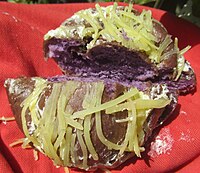Ensaïmada
This article includes a list of general references, but it lacks sufficient corresponding inline citations. (August 2016) |
 Ensaïmadas | |
| Alternative names | Ensaimada |
|---|---|
| Course | Pastry |
| Place of origin | Mallorca, Balearic Islands, Spain |
| Serving temperature | Cold |
| Main ingredients | Flour, water, eggs, mother dough, saïm (reduced pork lard) |
The ensaïmada is a pastry product from Mallorca, Balearic Islands, Spain, commonly found in southwestern Europe, Latin America and the Philippines.
The ensaïmada de Mallorca is made with strong flour, water, sugar, eggs, mother dough and a kind of reduced pork lard named saïm in Catalan, which gives the pastry its name. The handmade character of the product makes it difficult to give an exact formula, so scales have been established defining the proportion of each ingredient, giving rise to an excellent quality traditional product.
The pastry apparently has a Jewish origin, deriving from bulemas, using lard instead of olive oil as a means of escaping the suspicions of the authorities during the Inquisition.[1] The first written references to the Mallorcan ensaïmada date back to the 17th century. At that time, although wheat flour was mainly used for making bread, there is evidence that this typical pastry product was made for festivals and celebrations.
In Mallorca and Ibiza, a sweet called greixonera is made with ensaïmada pieces left over from the day before.[2]
Variants
[edit]The Balearic Islands
[edit]Among the variants of ensaimada the most common are:
- Llisa (literally "plain") with no extra ingredient.
- Cabell d'àngel (literally "angel's hair"), the stringy orange strands found inside pumpkins are cooked with sugar to make a sweet filling that is rolled inside the dough.
- Tallades (literally "sliced") covered with sobrassada and pumpkin, obtaining a bittersweet taste. It is typical of Carnival days, just before Lent, when meat (including lard and sobrassada) are not supposed to be eaten.
- Crema (literally "cream") with cream made with eggs.
- Filled with sweet cream, chocolate or turrón paste.
- Covered with apricot.
The Philippines
[edit]

The Philippines also adopted the Mallorcan ensaïmada (commonly spelled ensaymada in Philippine languages). As a Spanish colony for over 300 years, the Philippine variant has evolved over the centuries and is perhaps one of the most common delicacies in the country. The localized pastry is a brioche baked with butter instead of lard and topped with grated cheese and sugar and can be found in almost all neighborhood bakeshops. Other versions are topped with buttercream, salted egg slices, and a specially aged type of Edam cheese called queso de bola. The ensaymada of Pampanga features a very rich dough with layers of butter and cheese. It is custom to eat ensaymada with hot chocolate made with native tablea during the Philippine Christmas season.
Due to its popularity, bakeshop chains such as Goldilocks, Red Ribbon, Julie's, Pan de Manila, and Balai Pandesal offer ensaymada with their own recipes.
Puerto Rico
[edit]In Puerto Rico, another Spanish colony until 1898, the ensaïmada is called pan de mallorca[3] and is traditionally eaten for breakfast or as an afternoon snack.
See also
[edit]References
[edit]- ^ Morrow, Madeleine (2016-01-18). "Mallorca's history is coiled in a pastry". The Boston Globe. Retrieved 2023-09-14.
- ^ Flaó and Greixonera Archived 2011-09-19 at the Wayback Machine
- ^ "Pan de Mallorca | Traditional Bread From Puerto Rico". Taste Atlas. Retrieved 2020-12-03.
External links
[edit] Media related to Ensaïmada at Wikimedia Commons
Media related to Ensaïmada at Wikimedia Commons- The ensaimada Report by MallorcaWeb, in English
- Artisan baker and ensaïmada chef, in English
- [1] General interest about ensaïmadas and vegetarianism, in English
- Traditional ensaïmada recipe Take a taste of Mallorca, in Spanish
- Traditional Ensaimadas of Pampanga, Philippines

